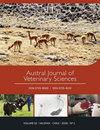Vaccination of nulliparous gilts against porcine epidemic diarrhoea can result in low neutralising antibody titres and high litter mortality
IF 0.8
4区 农林科学
Q3 VETERINARY SCIENCES
引用次数: 0
Abstract
Porcine epidemic diarrhoea (PED) is a disease caused by an alphacoronavirus and the symptoms include watery diarrhoea and vomiting, with more than 80% mortality amongst newborn piglets. The placentation in sows hinders the transference of antibodies to the foetus, therefore, the vaccination of pregnant females and transference of antibodies to piglets through colostrum are essential to protect them against virus particles. The aim of the study was to determine whether vaccination of nulliparous gilts could induce a high colostrum antibody titre and lower litter mortality, in comparison with vaccinated multiparous sows previously exposed to the virus. Samples of colostrum were obtained from 11 nulliparous gilts with two previous vaccinations (inactivated vaccine) and from 9 multiparous sows with three or more vaccinations (inactivated vaccine) that had been exposed to the virus. The IgG antibody titre was determined through anti-PED enzyme-linked immunosorbent assays (ELISA) and the neutralisation of antibodies was evaluated through plaque reduction neutralisation tests (PRNT). The colostrum of nulliparous gilts, when compared to the multiparous sows, presented a lower anti-PED IgG antibody titre as well as fewer neutralising antibodies. Furthermore, the piglets of multiparous sows experienced higher survival in comparison with those of nulliparous gilts (P<0.01), and mortality was dependent on the ‘farrowing’ variable (P<0.01). In conclusion, these results show that vaccinating nulliparous gilts does not increase the survival of their piglets in comparison with multiparous sows and that the IgG titres and neutralising antibodies are significantly lower in the former. These results suggest that a modified vaccine strategy is needed for nulliparous gilts to increase piglet protection.为未产仔接种猪流行性腹泻疫苗可导致低中和抗体滴度和高产仔死亡率
猪流行性腹泻(PED)是一种由甲型冠状病毒引起的疾病,症状包括水样腹泻和呕吐,新生仔猪的死亡率超过80%。母猪的胎盘形成阻碍了抗体向胎儿的转移,因此,孕妇接种疫苗和通过初乳向仔猪转移抗体对于保护它们免受病毒颗粒的侵害至关重要。该研究的目的是确定与之前接触过该病毒的接种过疫苗的多胎母猪相比,未出生母猪的疫苗接种是否可以诱导高的初乳抗体滴度和较低的产仔死亡率。从11头接种过两次疫苗(灭活疫苗)的未产仔母猪和9头接种过三次或三次以上疫苗(灭活疫苗)的多胎母猪身上采集了初乳样本。IgG抗体滴度通过抗PED酶联免疫吸附试验(ELISA)测定,抗体的中和通过斑块减少中和试验(PRNT)评估。与经产母猪相比,未产仔母猪的初乳具有较低的抗PED IgG抗体滴度和较少的中和抗体。此外,与未产仔母猪相比,经产母猪的仔猪存活率更高(P<0.01),并且死亡率取决于“产仔”变量(P<0.01),这些结果表明,与多胎母猪相比,接种未产仔母猪疫苗并不能提高其仔猪的存活率,并且前者的IgG滴度和中和抗体显著较低。这些结果表明,需要对未产仔母猪进行改良的疫苗策略,以增加对仔猪的保护。
本文章由计算机程序翻译,如有差异,请以英文原文为准。
求助全文
约1分钟内获得全文
求助全文
来源期刊

Austral Journal of Veterinary Sciences
Veterinary-General Veterinary
CiteScore
1.60
自引率
0.00%
发文量
18
期刊介绍:
Austral Journal of Veterinary Sciences (formerly Archivos de Medicina Veterinaria) publishes original scientific contributions in English, containing the latest developments and discoveries in veterinary sciences. The journal covers topics such as animal health and production, preventive medicine, zoonosis, pharmacology and therapeutics, methods of diagnosis, and other areas related to the veterinary field.
Austral Journal of Veterinary Sciences aims to divulge information about advances in veterinary medicine among universities, research centres, industries, government agencies, biologists, agronomists and veterinarians.
 求助内容:
求助内容: 应助结果提醒方式:
应助结果提醒方式:


